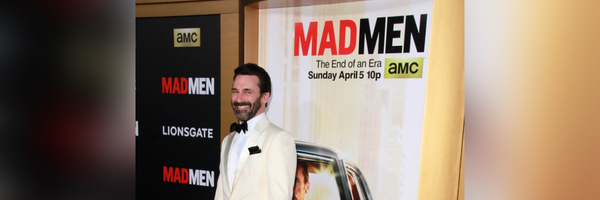-

The Best America has to Offer
Posted By Scott Edenfield
My wife and I have found ourselves to be inconsolable after a large void recently appeared in our lives. I know what you are thinking, and you are exactly right - we are grieving over the loss of Mad Men.
AMC’s award-winning period drama, following the personal and professional travails of Don Draper in the advertising world’s mid-twentieth century zenith in New York, concluded with its seventh and final season in May. I am not here to debate where the finale ranks in the pantheon of television finales as there are plenty of other places on the internet for such debate.
However, as is typical whenever anything in our lives comes to a conclusion, I have found myself reminiscing about the show’s beginning and some of the iconic scenes that caused me to become enthralled with the show. In case you aren’t familiar with the show, go to YouTube, find the Kodak pitch, and you will likely become hooked.
In the first half of season one, there is a scene where Don is discussing the status of various clients after a night celebrating his agency’s recent industry award. One of these clients is the fictional Liberty Capital Savings Bank that has turned to Sterling Cooper (the name of Don’s firm) to develop a ground-breaking promotion/product to drive traffic into their bank in the face of flat interest rates and dwindling face-to-face interactions with customers. Misogynistic overtones of the ensuing dialogue excluded, it is likely this conversation mirrors internal discussions that are happening in many Product Development committees today.
The development of a silver-bullet offering that represents an industry revolution is sometimes the “white whale” that Product Development committees may feel that they have been tasked with slaying. The truth is that such products rarely materialize. Their time could be better used to analyze their current product portfolio, and determine where each product is in its life cycle to ensure the institution is not at a competitive disadvantage with its product mix. The goal would be to determine if the institution would benefit the most from various tweaks to current offerings, a complete overhaul of the entire product portfolio, or perhaps somewhere in between.
During Don's discussion with his team it was relayed to him that the Bank's president wanted a strategy developed that would draw more traffic of a particular customer segment into their bank. However, as Don points out, the strategy that the president is asking for contains a fundamental flaw as it doesn't reach the actual customers that the bank wants to attract.
This is an important issue that must be addressed and understood before any product evaluation is undertaken. What financial products and services are your existing customers looking for you to provide to them? If their needs aren't being met, what are the necessary changes that must be made, or are you willing to allow these customers to look elsewhere for these needs?
If the goal is to attract new customers, it's imperative that the Product Committee understand what that target customer looks like from a needs perspective. However, knowing that a customer’s needs change during the course of their lifetime, it will be necessary for the product portfolio to be dynamic enough to meet a customer's evolving needs.
In my opinion, there can be two potential conclusions for this fictional bank president.
Conclusion 1: The fictional bank president did recognize a very important truth that can sometimes be difficult to acknowledge - it's okay to ask for help. Leveraging internal resources for smaller initiatives can often be the best course of action, as there is less effort required to bring outsiders up to speed and there are fewer "cooks in the kitchen". It can also ensure that changes are implemented quickly. However, when significant results are sought, it often can be best to engage an expert with a demonstrated track record of delivering meaningful results.
Conclusion 2: If nothing else the bank president can provide a diverse yet straightforward array of product options. This can provide customers with the perception that the institution they've chosen to partner with will be able to satisfy their needs today, tomorrow and beyond, thereby giving them peace of mind and the confidence to, "enjoy the best America has to offer".
